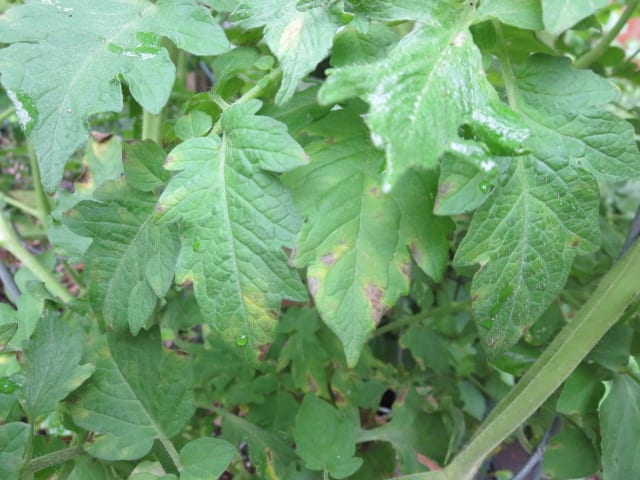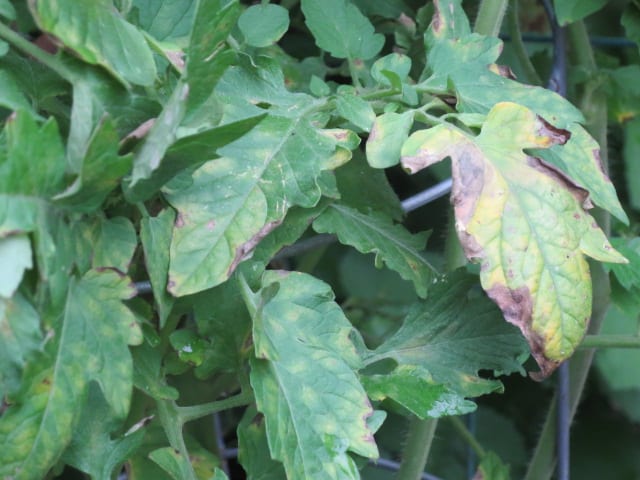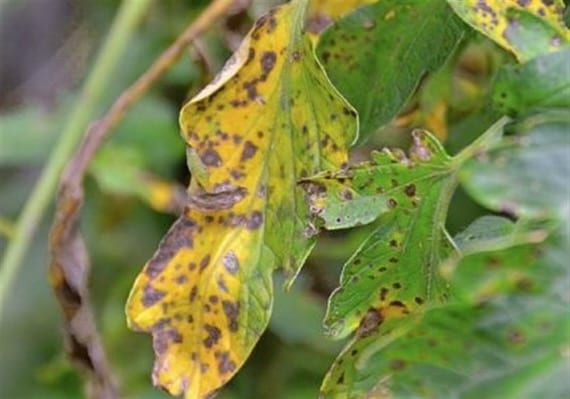Early leaf blight can quickly turn the dream of growing a tomato plant into a nightmare. One day you are enjoying the progress in the growth of your tomato plant and the next you are watching it being taken over by this gnarly disease. Early detection is key to this quickly spreading pathogen. We’ll talk about the signs, treatment and prevention of early leaf blight in this latest Happy Gardener post.
Early leaf blight is a fast growing disease that has a hankering for tomato plants. High humidity and warm temperatures are elements that contribute to the development of early leaf blight. The disease generally first presents itself on the lowest leaves of your tomato plants and quickly travels up the plant.


Signs of Early Leaf Blight on Tomato Plants
Brownish/black splotches start to appear on the leaves closest to the soil. As you can see in the above pic, it starts off kind of small and inconspicuous, but will quickly grow into a bigger problem (featured pic). If you look closely at the center of the spots on your plant, you may see a concentric pattern, like a bulls eye. The areas surrounding the blotches usually start to turn yellow. As the foliar disease progresses, the affected leaves then take on a leathery-shriveled appearance and begin to wither and die. Unfortunately the disease doesn’t die with it. It just greedily moves up the plant to claim more foliage, and even attacks the stems and eventually fruit (if you let it get that far). Early leaf blight weakens the plant and reduces the size and the quality of fruit. This disease can affect your tomato plant at any stage of growth.
Sounds pretty grim, right? The good news is that early leaf blight can be controlled AND even better (know that you know about it) can be prevented. Early detection is crucial to controlling this disease, as it really is a quick spreader. It’s also good to note that while this disease has “early” in it’s name, it can attack your tomatoes at any stage of its growth. So, watch out!


Control of Early Leaf Blight on Tomato Plants
First step is to remove as many of the damaged leaves as possible. Pinch or prune them off and throw them in a bag to dispose of them immediately. Be sure to scour the soil around the plant and remove any fallen leaves there as well. Spores from early leaf blight can survive in the soil for years; removing all infected tissue from the area is most important.
After you have discarded infected plant material, choose your weapon. Organic gardeners can look at a fungicide that has copper for its main ingredient such as Liquid Copper Fungicide from Bonide. If organic is not a priority, you can use a product safe for edibles like Daconil Fungicide. The key here will be to remember any follow up applications according to the instructions on your fungicide. Usually you will need to repeat treatment every 7-10 days, especially during consistent rainfall periods, to get early leaf blight under control (but please read information on your specific label). If you didn’t notice the disease early and it has already spread all the way up the plant, you might want to chalk it up to a learning lesson and make plans to visit some farmer’s markets for your fresh tomatoes this season.
The best thing to arm you with is the knowledge of how to avoid this disease in the first place. Before you know, it will be mid July and time to plant tomatoes for your fall crop, so let’s figure out how to prevent this carnage from happening all over again.
Preventing Early Leaf Blight on Tomato Plants
Crop Rotation: If you had tomato plants last year that suffered from early leaf blight, and you planted new plants in the same area this year, you are more likely to experience the problem again. It is not always known, but always advised, to rotate your crops each year to limit the risk of contamination from previous soil-dwelling disease. Plant a crop that is not affected by early leaf blight ( ) for a few years before allowing a tomato plant to revisit the site.
Soil Health: Soils rich in compost and beneficial microbes greatly reduce the risk of soil dwelling disease like early leaf blight. Start with the best soil possible, rich in organic matter like compost, peat moss, and other organic ingredients that lend to soil health and you may not encounter this disease at all. For an extra defensive boost, mix in a product like Happy Frog Jump Start fertilizer (which contains active soil microbes), or Espoma’s Bio-tone Starter Plant Food Plus Mycorrhizae, to give your soil a fighting chance against those nasty fungi.
Adequate Spacing: You must take in account how big your veggies are supposed to get at their mature size. When you crowd your plants you don’t give them enough room for adequate air circulation. Ever been in a hot, stuffy, crowded elevator finding it hard to breathe? That’s pretty much what it feels like for your tomato plants when they are planted too close together. Tomato plants, especially indeterminate varieties, can grow to monster proportions. They really should be planted no less than 3 feet apart for optimal growth and vigor (further if you can). Crowding = no air circulation = opportunity for early leaf blight.
Tomato Variety: Some varieties of tomatoes are just prone to more disease issues. When you are choosing your tomatoes for spring and fall plantings, research your desired tomato varieties and their disease resistance. Chose tomatoes by the recommended varieties from the TAMU Agrilife Extension Office each year. These tomatoes are chosen based on their disease resistance, vigor, taste, appearance, and adaptability to our climate.
Water and Mulch: Watering techniques can affect the probability of developing disease in your tomato plants. Water needs to be gently delivered to the base of your plant by the roots, the only place your tomato plants take up water. There is no benefit to watering the tops of your plants, you’re not cooling them off during a hot summer day, you are increasing their chance for leaf scald, and allowing water to splash up off the soil, increasing the chance of early leaf blight being delivered to the lower foliage.
A layer of mulch around the bottom of the plant provides a barrier between the soil and foliage for times when it rains or when you are splashing the soil while watering with a hose, garden pitcher, or sprinkler (stop that). Mulch can greatly reduce early leaf blight from attacking the lower leaves of your tomato plant from (one of the favorite ways the disease likes to spread).
I truly hope you don’t have to experience battling early leaf blight this season, and that if you do, you are able to catch it early. Keep this advice in your mind for next fall too; early leaf blight hits us in both growing seasons.
~The Happy Gardener, Lisa Mulroy


Trackbacks/Pingbacks